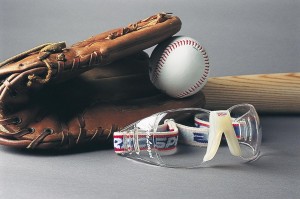 Every year, hospital emergency rooms treat nearly 40,000 victims of sports eye injuries. Unfortunately, 90% of these injuries could be prevented by participants in sports using proper eye protection. All professional and recreational athletes participating in eye-hazardous sports need to wear eye protection. To help prevent sports eye injuries, protective polycarbonate eyewear should be worn whether or not prescription eyewear is needed. Regular street wear glasses do not provide adequate eye protection, these lens are susceptible to shattering and causing significant injury by flying pieces. Polycarbonate lens are 20 times more shatter resistant than traditional glass and therefore provide better protection for the eyes.
Every year, hospital emergency rooms treat nearly 40,000 victims of sports eye injuries. Unfortunately, 90% of these injuries could be prevented by participants in sports using proper eye protection. All professional and recreational athletes participating in eye-hazardous sports need to wear eye protection. To help prevent sports eye injuries, protective polycarbonate eyewear should be worn whether or not prescription eyewear is needed. Regular street wear glasses do not provide adequate eye protection, these lens are susceptible to shattering and causing significant injury by flying pieces. Polycarbonate lens are 20 times more shatter resistant than traditional glass and therefore provide better protection for the eyes.
The sports that cause the most eye injuries are basketball, baseball and racket sports, but any sport where something flies at the eye is considered hazardous. Unbreakable glasses, goggles or facemasks are required when there is a potential for eye injury. Polycarbonate lenses are unbreakable and make excellent protection for the eyes.
Helmets with eye shields are recommended for football and other contact sports. Many sports, such as baseball, hockey and men’s lacrosse require a helmet with polycarbonate facemask or wire shield. Face guards can be worn over polycarbonate glasses, and are used primarily for football, ice hockey and similar high-risk sports. Some sports at the national level, such as hockey, have established standards for eye protection.
Goggles or sports glasses protect eyes while playing basketball, racquet sports, handball, and soccer. These goggles should be made of polycarbonate, which is 20 times stronger than ordinary eyeglass material. Prescription eyewear used during sports should be made from polycarbonate.
For high-speed sports such as skiing, wear special frames sturdy enough to protect the eyes from any impact. Wear ultraviolet absorbing goggles or sunglasses while skiing to protect the eyes from glare, ultraviolet rays and exposure to weather.
Boxing presents a high risk for eye injury, and unfortunately, there is no adequate protection available.
Contact lenses are not a form of protective eyewear. Contact lens wearers require additional protection when participating in sports.
People with only one functional eye should carefully consider the risks of sports.. Additionally those individuals who have undergone prior eye surgery (cataract, glaucoma, retinal and refractive surgery) should understand that their eye may be more vulnerable to injury and should take appropriate precautions. Unfortunately, no adequate eye protection is available for boxing, martial arts and wrestling, and therefore participation in these sports should be avoided by those individuals with either one functional eye or an eye structurally weakened by surgery.
Wearing adequate eye protection at all times is essential for people with only one eye.
Because a majority of the sports eye injuries can be prevented with proper eye protection – it is essential that all participants in sports use appropriate eye protection.
